Solar Panel Performance: Winter vs Summer (Guide 2023)
By: HomeOtter Team
Mar 30th 2023
Time: 11min
Have you ever wondered how solar panel output winter vs summer differs? If you're thinking if it matters as long as your solar panels produce enough energy to power your home, well, understanding how solar panels generate energy during different seasons can save you some serious green – both in terms of money and the environment.
To answer this in more detail, we’ve come up with a guide where we’ll discuss the impact of these two seasons on solar energy production, from daylight hours to temperature to pesky snow and ice. We'll also get into the specifics of how solar panels generate energy.
By the end of this 10-minute read, you’ll not only be familiar with how this solar production process is affected by seasonal changes but you’ll also learn some practical ways for maximizing your solar energy production during the extreme months.
Solar Panel 101: Understanding The Basics Of A Solar Panel System
Before we start discussing solar panel efficiency during winters and summers, you need to understand how their work. Let’s discuss this.
A. How Do Solar Panels Work?

Photovoltaic cells are the main element in solar panels that are responsible for the actual change that is converting sunlight into DC electricity. The cells are typically made of silicon, a non-metallic chemical element that conducts electricity.
When sunlight hits the solar panels, the cells absorb energy from it and create a flow of electrons. This flow of electrons creates a direct current that is used to power electrical devices. Then the solar system uses the inverter to convert DC to AC – a type of current that we use in our homes.
B. Efficiency & Performance Metrics
Solar panel efficiency is the ratio of solar energy that is converted into usable electricity. The efficiency of solar panels is measured in percentage. So if a solar panel has an efficiency rating of 15%, it means that out of all the energy it receives from the sun, it can convert 15% of that into electricity.
The efficiency of a solar panel is affected by various factors, including:
- Temperature
- Type of solar panel
- Angle and orientation of the panels
- Amount of sunlight the panels receive
We can measure the effectiveness of a solar panel via certain performance standards. The two most common ones are.
- Capacity Factor: It is the ratio of the actual energy produced by a solar panel system to the maximum amount of energy that could have been produced.
- Performance Ratio: It measures the ratio of the actual energy output to the expected energy output based on the solar irradiance received.
By knowing these efficiency and performance metrics, you can monitor the overall performance of your solar panel system during different seasons and take the necessary steps to improve it.
C. The 3 Different Types Of Solar Panels
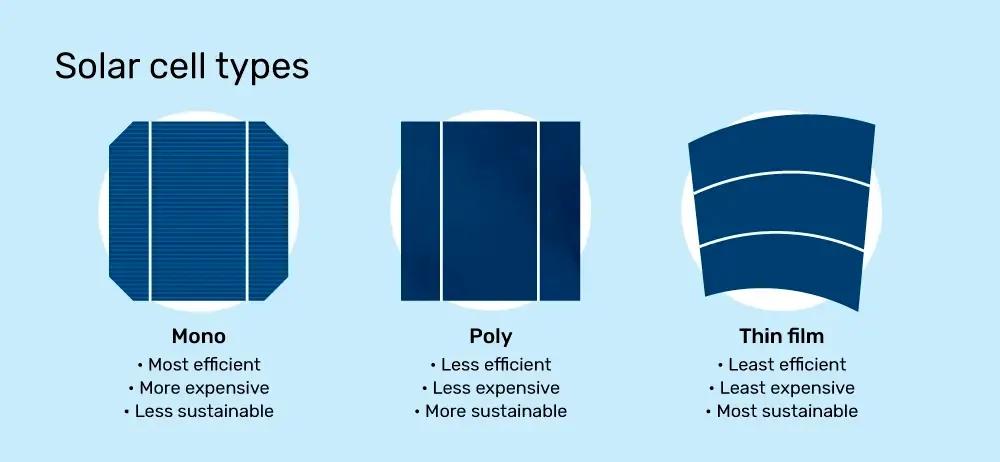
3 main types of solar panels available are:
C.1 Monocrystalline Solar Panels
Also known as single-crystalline" solar panels, monocrystalline panels are made from a single, pure crystal of silicon. These panels are the most efficient, converting 15-22% of sunlight into usable energy. They have a uniform, dark appearance and are often considered the most aesthetically pleasing option.
One potential drawback of monocrystalline solar panels is their cost. They are typically the most expensive option because of their high efficiency and advanced manufacturing process. They are also the most sensitive type when it comes to shading.
C.2 Polycrystalline Solar Panels
Commonly known as multi-crystalline solar panels, polycrystalline panels are made from multiple crystals of silicon. They have a blueish tint and are typically less expensive than monocrystalline solar panels. However, they are also less efficient and have an efficiency rating of only 13-16%.
Since they are less sensitive to shading, they are a better option for areas with partial shading. They also have a shorter manufacturing process than monocrystalline panels, which can contribute to their lower cost.
C.3 Thin-Film Solar Panels
Thin-film panels are made from a thin layer of photovoltaic material that is deposited onto a substrate, glass, plastic, or metal. They are the least efficient type of solar panel, typically converting only around 7-12% of sunlight into usable energy. However, they are also the least expensive and can be flexible, making them easier to install in unique locations.
Thin-film solar panels perform well in high temperatures. They also have a lower sensitivity to shading than other types of solar panels. However, they have a shorter lifespan than other types of solar panels and require more frequent maintenance and replacements.
Now that we know the basics of solar panel work, let’s discuss how they perform in winter.
Analyzing Solar Panel Performance During Winter
It’s now time to take a look at how well solar panels work in winter and see if the reduced solar production in winter increases energy bills.
I. Solar Irradiance In Winter
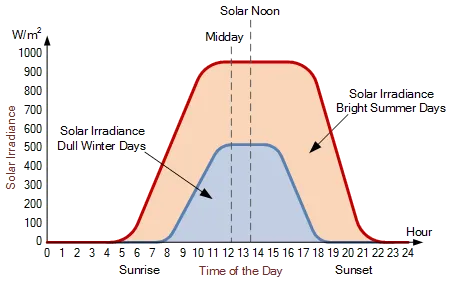
Solar irradiance is the power received from the sun in electromagnetic form. It is a common fact that during the winter months, the angle of the sun is lower in the sky.
This causes the sunlight to travel through more of the earth's atmosphere which eventually reduces the amount of energy that reaches the solar panels. Additionally, winter days are shorter which means there are fewer daylight hours for the solar panels to produce energy.
II. Temperature Effect On Solar Panel Performance During Summer
While solar panels are designed to generate electricity using sunlight, they also need an ideal temperature for optimal performance. In general, solar panels perform best at moderate temperatures.
In colder temperatures, the voltage output of the solar panels increases which causes the electrical output to rise. However, this can backfire as well. If solar panel systems are not designed to cope with extreme fluctuations, they can be easily damaged.
III. Shading Effect In Winter
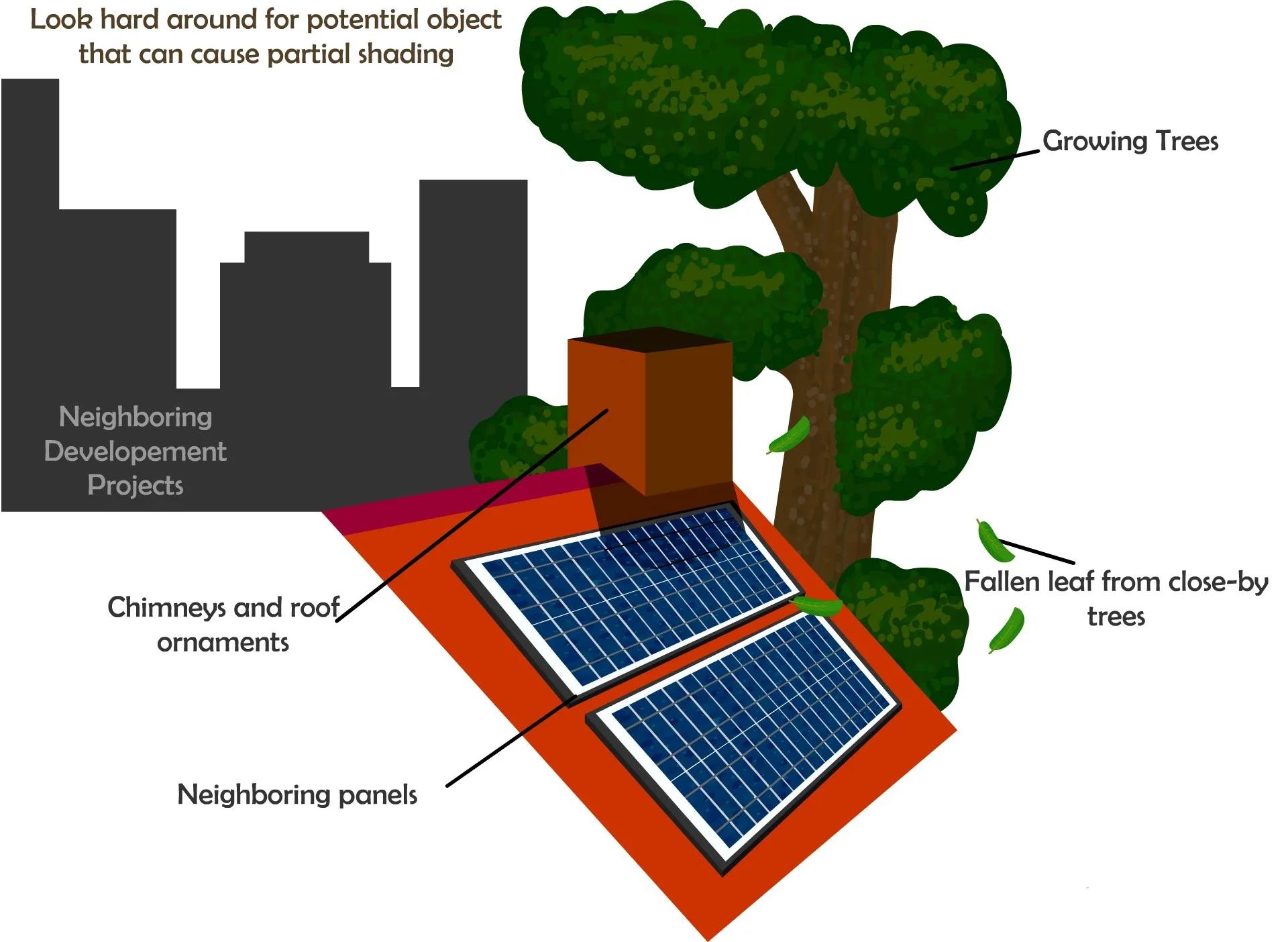
Even a small amount of shading significantly reduces the amount of solar energy produced by the panels, impacting the overall energy output of the system. Even in a location with little to no shading, there may still be periods of the day when the sun is not shining directly on the panels. This can decrease the amount of energy produced by solar panels.
IV. Snow & Ice Effect On Solar Panels
Snow and ice can also impact solar panel output. When snow or ice covers a solar panel, it can end up blocking the sunlight from reaching the solar cells. That’s not all – the weight of the snow or ice can also cause some serious damage to the solar panels, making the panels perform worse over time.
V. Angle & Orientation In Winter
For capturing the most sunlight possible, install solar panels at an appropriate angle and orientation. The sun is lower in the sky during winter which means that the angle of the solar panels needs to be adjusted to capture the most sunlight. In addition to adjusting the angle of the solar panels, it's also important to consider their orientation.
Now that we are familiar with the factors that influence solar power production during winter, let’s see how we can optimize their performance.
4 Proven Ways To Improve Solar Panel Performance In Winter
It’s time to see how you can lessen the impact of winter harshness on your solar panels.
1. Remove Snow And Ice From Solar Panels
Some people may think that the snow and ice that accumulate on their solar panels during the winter months will naturally clean them. Not true at all. In fact, snow and ice can actually make your panels less efficient by blocking the sun's rays and reducing their ability to generate electricity.
Use a soft brush or a gentle hose. Be careful not to use any abrasive materials or harsh chemicals that could damage your panels.
2. Choose The Right Angle & Orientation
The ideal angle for solar panels during the winter months will depend on the latitude of the installation site. People living in the northern latitude will want to tilt their panels at a steeper angle than the ones living in the southern latitude. Ideally, solar panels should be installed tilted at an angle equal to your latitude plus 15°.
Using a solar angle calculator is the best way to determine the ideal angle for your panels. Make adjustments based on the specific conditions in your area. Note that adjusting the angle of your solar panels is not a one-time fix.
You need to adjust the angle periodically throughout the winter months to ensure that your panels are always positioned optimally to capture as much sunlight as possible.
Similarly, solar panels installed on a south-facing roof will typically receive the most sunlight during the winter months in the northern hemisphere.
3. Use A Solar Tracker
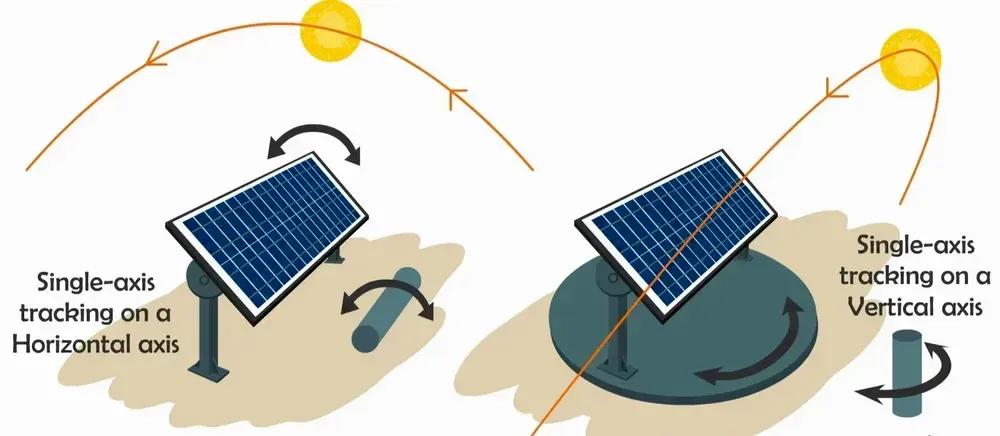
Solar tracker follows the sun as it moves across the sky and keeps your panels always positioned optimally to absorb the maximum amount of sunlight.
Solar trackers come in a variety of different types.
- Single-axis trackers move your panels along a single axis, typically east to west
- Dual-axis trackers move your panels along two axes, allowing them to track the sun's movement more precisely
While solar trackers can be more expensive than fixed panels or adjustable mounts, they can significantly increase the energy output of your solar system, making them a worthwhile investment for many homeowners.
4. Use A Solar Panel Heating System
To combat snow and ice, you can install a solar panel heating system. It typically consists of a small heating element that is installed on the back of your solar panels. This heating element is powered by a separate solar panel or can be connected to your existing solar system.
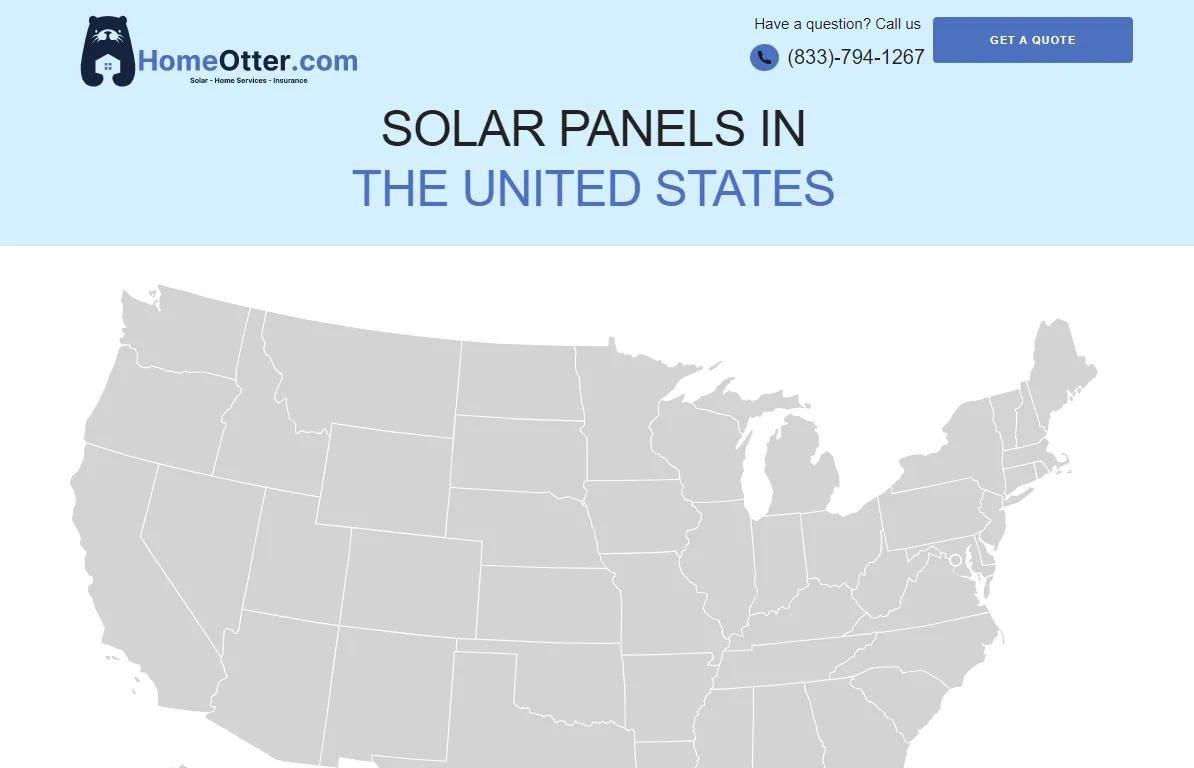
At HomeOtter, we know the art of solar panels. We partner with only the best solar panel companies in your area who know exactly what your local weather demands from solar panels.
By opting HomeOtter, you'll get a solar panel system that's optimized for your area's weather conditions. Our partner companies specialize in developing solar panel systems that can give you the best possible results, no matter what the weather is like.
Getting started with HomeOtter is easy. Simply fill out our questionnaire and you'll get a customized solar report that provides you with all the details and costs involved in installing a solar panel system at your home. All this in 4 minutes.
Now that we’ve learned the ways to enhance solar panel performance during winter, let’s see how summer impacts their performance.
Analyzing Solar Panel Performance During Summer
Like most people, you’d also expect the most out of your solar panels during summer. Again, not always true. Despite the longer days, lessened solar production is a common problem in the summer season, which could lead to increased energy usage and bills. Let’s discuss the key factors for this.
a. Solar Irradiance In Summer
Like winters, solar irradiance is a crucial factor that affects the performance of solar panels during the summer season. There is generally more solar irradiance in summer because of the longer days and the sun being higher in the sky so the panels should produce more energy.
But some other factors affect solar irradiance during summer. Cloud cover reduces the amount of solar irradiance that hits the surface. Similarly, air pollution also affects the amount of solar irradiance.
b. Temperature Effect On Solar Panel Performance During Summer
Solar panels work best at lower temperatures, and as temperatures rise, their efficiency decreases. And the reason is simple - higher temperature equals higher resistance in solar cells. This increase in resistance makes it hard for the electrons to flow through the solar cells and generate electricity.
The temperature of solar panels can also impact their lifespan. Expose them to high temperatures for prolonged periods and the solar cells will degrade, leading to a dip in their efficiency over time.
c. Shading Effect In Summer
Shading is another important factor that can impact solar panel performance during the summer season. Even small amounts of shading can have a significant impact on solar panel performance during summer.
When solar panels are shaded, electricity production can be impacted in a few different ways. In some cases, the shaded cells can start to act like resistors which can cause the voltage to drop across the panel. This leads to less energy production and also causes hot spots to form on the panel which can damage the cells.
In addition to reduced energy production, shading can also cause imbalances in the solar panel array. Since not all cells are producing the same amount of energy, mismatched currents and voltages can occur. This causes damage to the solar panel system and reduces its lifespan.
d. Angle & Orientation In Summer

During the summertime, the sun's angle and intensity change, and solar panels must be angled and oriented properly to capture as much sunlight as possible.
Earth's axial tilt is one of the main causes of changes in the sun's angle and intensity during summer. This tilt causes the sun's angle and intensity to vary throughout the year, with the summer season having the most direct sunlight and the longest days.
The impact of angle and orientation on solar panel performance during the summer season can be significant. If solar panels are not angled or oriented properly, they won’t receive enough sunlight to produce the maximum amount of energy.
Angling the solar panels too steeply or shallowly will have repercussions. Either they won’t receive enough sunlight or they’ll overheat. No matter which way you slice it, the solar panels will be a letdown and will underperform.
Now that we know how summer affects solar panels, let’s take a look at the ways which improve their efficiency.
4 Proven Ways To Improve Solar Panel Performance In Summer
Here are some great strategies to improve solar panel output during summer days.
i. Managing Temperature & Cooling
Choose the right type of solar panel to manage the temperature and cooling. Some solar panels are inherently designed to be more heat-resistant than others and they can perform better in hot and sunny weather. One such type is monocrystalline solar panels which are known to be more resilient than their counterparts, polycrystalline solar panels.
Cooling systems are another effective way to manage the temperature. It reduces the temperature of your solar panels by circulating water or air through the panels. The most well-known types of cooling systems are:
- Active cooling systems
- Hybrid cooling systems
- Passive cooling systems
ii. Install Your Solar Panels At The Right Angle
Installing your solar panels at the right angle can maximize their performance and electricity generation during the summer season. The ideal angle for solar panels depends on your location and latitude. In general, for locations in the northern hemisphere, solar panels should be installed facing south and tilted at an angle equal to your latitude plus 15°.
So people living in places with a latitude of 40° should angle their solar panels at 55° (40° + 15°). Similarly, for locations in the southern hemisphere, solar panels should be installed facing north and tilted at an angle equal to your latitude minus 15°.
iii. Use Anti-Reflective Coating
One important thing that helps solar panels function effectively during summer is something called anti-reflective coating. It's a super thin film that gets added to the surface of the solar panel to keep the sunlight from reflecting off and going to waste. Instead, the coating helps the solar cells absorb more of the light, which leads to better efficiency and more electricity generation for your solar panel system.
iv. Managing Shading
During the summer months, shading can be particularly problematic because of the higher intensity and angle of the sun's rays. Microinverters or power optimizers can help manage shading by allowing each solar panel to operate independently of the others. With a traditional solar panel system, if one panel is shaded, it can drag down the performance of the entire system.
Microinverters or power optimizers help to mitigate this issue by converting the DC power produced by each panel into AC power independently, allowing shaded panels to still contribute to the overall system output.
Bypass diodes are small electronic devices that can be installed on solar panels to help manage shading. They work by allowing the current to flow around a shaded panel instead of through it, minimizing the impact of shading on the overall system performance.
Conclusion
When we talk about factors that prominently impact the energy production of your solar panels, the solar panel output winter vs summer debate tops the list. It's not just about the longer days and stronger sunlight - it's a whole science thing.
In the winter, solar panels can perform better on colder, sunnier days. On the other hand, in the summer, solar panels may be subject to efficiency losses because of high temperatures. While summer may be ideal for some areas, winter could be the better season for others.
HomeOtter is the premium solution to help you choose the best solar panel installer in your area. At HomeOtter, we only work with the best solar panel companies that offer state-of-the-art panels which can withstand any weather conditions.
The companies that we work with have solar panel experts who will analyze the weather in your area and recommend the solar panels that work best for you. With our online solar report, which is absolutely free, you can get an accurate idea of the solar panel size that you need for your home. Get your solar report now and see the difference for yourself.
